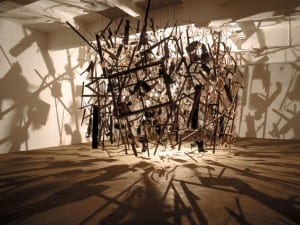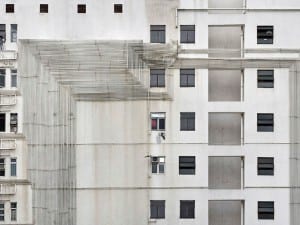London-based artist Salvatore Arancio talks with Aesthetica about science, sampling and psychedelia in his solo show at Rowing Projects. Titled Alternating Layers of Contrasting Resistance, the exhibition has been put into dialogue with Samara Scott’s cabinet room project Cd0xdsspi.
A: Alongside more traditional formats such as photo-etching, ceramic sculpture and collage, the plasma screen presentation of Window of Possible Development (2013) presents a contrast. Does Window demonstrate a growing interest in digital technology?
SA: It’s not all that straightforward, though to a certain degree you might interpret it that way. The contrast was intentional and I see the black screen as a kind of window, a void, or a space within the space. I’m interested in digital technology and it obviously plays a strong part in this work, but it’s also more subtly present in other works: in my photo etchings I scan images from scientific books dating back to the 19th-century, and work with them in Photoshop. By editing and combining different elements from different illustrations I elaborate my own image and, when I feel it’s ready, I turn it back into an etching using a process known as photo-etching. What I find exciting is the idea of combining new technologies with “outdated” techniques – reviving and reinterpreting them, aiming to create new hybrid forms of communication.
A: How about the content of this work?
SA: It’s an animation inspired by the work of the 17th-century German Jesuit scholar Athanasius Kircher, a real Renaissance man who was deeply invested in geology and volcanology. Window follows my interest in the aesthetics linked to the enquiry into science and nature: the two round shapes you see slowly rotating on screen were created by manipulating Kircher’s illustration Mundus Subterraneus. He was trying to interpret and define the inside of the Earth: he drew fissures and tunnels where magma would mix and eventually flow through volcanoes. Kircher taught at the Collegio Romano, where he also built a museum collection called the Kircherianium, a typical baroque miracle chamber.
A: You seem drawn to museum culture and to the cabinet of curiosity – you’ve explored the idea in your video Birds (2012), and you’re participating in the Hayward touring exhibition Curiosity: Art and the Pleasures of Knowing, curated by Brian Dillon.
SA: I shot the footage for Birds at the zoological museum in Bologna, which contains part of Ulisse Androvandi’s collection, one of the first cabinets of curiosity and natural history collections. When I visited, I was most drawn to the vast Zafagnini-Bertocchi collection of stuffed birds from the early 20th-century. As I walked past myriad of cabinets, I felt almost like I was moving through film stills. The birds were displayed in tableaux, recreating moments of everyday life, though they were so old that some looked slightly shabby. I filmed in Super 8 and set the images to a piece by Expo 70, a composer based in Kansas City. He makes psychedelic, gravitational, rumbling music that sounds like something from the ‘70s Krautrock scene. When I came up with the idea of juxtaposing his sounds with the footage, I was thinking about some of Herzog’s “pseudo” documentaries like Fata Morgana, and the director’s association with cosmic musicians like the German electronic avant-garde band Popol Vuh. I wanted to reproduce the almost psychedelic experience I had when I walked into this museum, and also to alter the reading of the work.
The exhibition opens soon at Margate’s Turner Contemporary. The works included will hinge on the theme of curiosity: fantasies, fictions or parodies of the human quest for knowledge or truth. They’ll be juxtaposed with museum objects, such as a walrus taken from the Horniman museum. Some of my etchings will be in the show.
A: Have you been to Turner Contemporary yet?
SA: No, I’ve been to Margate though, and to Derek Jarman’s garden nearby, in Dungeness. I loved the landscape there. I visited partly because I was a big fan of Jarman in my youth. English culture was always a big influence, though I grew up in Sicily.
A: You’ve kept something from home in your work: volcanic landscapes recur in this exhibition.
SA: I grew up in Catania, the biggest city next to the volcano, but I didn’t intend for these landscapes to be seen as evocations of my past or to have a precise geographical origin – I want them to have an ambiguous temporality almost equidistant between an end and a beginning – images that might be pre-human, or have an apocalyptic quality.
A: Is that why you rarely include the human figure in your work? In some collages you seem to favour abstract geometrical forms.
SA: I started this series of collages while making a film called Sentinel, after the Arthur C Clarke story used as the basis of his novel 2001: A Space Odyssey, and Kubrick’s film of the same name. Many years after I first saw the movie, I noticed that my landscape images had something in common with Kubrick’s. But in the movie you also have the black monolith creating an impenetrable void within the frames. My geometrical forms are a way of introducing something similarly hard and manmade, changing the viewer’s reading of the image.
A: The act of sourcing and sampling film, sound and image seems so important in your work. I’ve been wondering how you came across the 1990s Russian cartoon used in Acis and Galatea? And where the black and white images come from?
SA: I tend to work from already existing material, although the black and white footage is my own, filmed on Super 8 on the Cyclopean islands in Sicily. I became interested in the myth associated with the islands, as well as their geological characteristics, composed in parts of hexagonal basalt columns. Supposedly, a cyclops was jealous of the relationship between a nymph called Galatea, and a shepherd called Acis. The cyclops tries to kill Acis by throwing stones at him. Some stones turn into the islands but one eventually kills Acis. Galatea goes to rescue him but when she touches the stone, Acis’ body turns into a river. So it was interesting how much mythology surrounded this place, but also how completely visionary the story was. After filming the landscape I researched the myth further and discovered on YouTube that it had been interpreted by a Russian animator. Amazingly, it seemed that the animator had depicted some of the very same aspects of the landscape that I’d shot on film. So I thought I’d use the similarities as a sort of device when I came to edit and splice the two materials together.
A: The colours in the animation are very unusual, and complement those of your sculptures.
SA: The choice of colour actually came about by accident. I was using my iPhone to send photos of the ceramic sculptures to my gallerist in Rome and somehow the camera was completely overwhelmed by the mixture of light sources in my studio. The lens couldn’t cope so it artificially reintroduced colours into the images, which I ended up liking. It made me think about the hallucinatory rituals that take place around certain natural settings. I wanted to hint at these so I tried to recreate the mistakenly produced colour in real life: I worked out a specific way of spray painting the engobes to achieve an almost glowing effect.
A: The form of the sculptures refers to natural phenomena. However, in transposing them into the exhibition space you’ve inserted them into an electronic, sonic landscape. What can we hear?
SA: The sound comes from Acis and Galatea and Window of Possible Development. These works won’t always be shown together but I wanted to try overlaying their soundtracks here. With Window I created the sound myself by sampling Coil’s album Time Machines (1998). There are four tracks on this album, with each one supposed to represent a different hallucinogenic drug, and playing with the viewer’s perception is an important element in my practice. For Acis and Galatea I collaborated with the London-based producer Hijacker. We discussed and referenced bands like the Tangerine Dream, Oneohtrix Point Never, White Noise, or Delia Derbyshire from the BBC Radiophonic Workshop: I’ve been looking back to people who wanted to make music for the future, which now, I find, has an almost nostalgic quality about it.
A: Sampling and recontextualising forgotten sounds seems a good way to draw attention to them again.
SA: That’s one of my intentions. I come up with the titles for my etchings through a kind of sampling too, though this is more playful – the titles sound scientifically convincing but they’re made up: I have an archive of captions referring to geological terminology and some of the words are just so obscure. I play with the inaccessibility of this language; creating titles by taking elements of existing terminology and reconfiguring them. It’s a kind of meaningful nonsense, though the titles still feel appropriate.
A: One thing I’ve been struggling to make sense of is the orange in the wall…
SA: That’s Samara’s! I like the way it highlights some of the similar colours we used. Also, it wasn’t an intentional reference, but my surname means orange as in the colour, or orange tree.
Words by Lizzie Homersham
Alternating Layers of Contrasting Resistance runs until 6 April at Rowing Projects
Curiosity: Art and the Pleasures of Knowing is a Hayward Touring exhibition opening at Turner Contemporary, Margate from 24 May – 15 September.
Castle Museum & Art Gallery, Norwich: 28 September – 5 January 2014
de Appel, Amsterdam: June – August 2014
Credits
1. Salvatore Arancio, Où le soleil recompose sa géométrie de lumière, 2012, ink and collage on printed paper, 25×19 cm Courtesy Federica Schiavo Gallery, Rome. Photo: Plastiques Photography.
2. Salvatore Arancio, Window of Possible Development, 2013, looped video animation with sound, 2′ 27″. Courtesy Federica Schiavo Gallery, Rome. Photo: Plastiques Photography.





